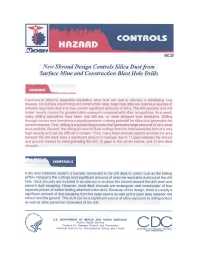Mining Publication: NIOSH Hazard Controls 27 - New Shroud Design Controls Silica Dust from Surface Mine and Construction Blast Hole Drills
Original creation date: November 1998
Exposure to airborne respirable crystalline silica dust can lead to silicosis, a debilitating lung disease. On surface coal mining and construction sites, blast hole drills are notorious sources of airborne respirable dust that may contain significant amounts of silica. The drill operator and drill helper usually receive the greatest silica exposure compared with other occupations. As a result, many drilling operations have been, and still are, on more stringent dust standards. Drilling through various rock formations naturally presents a strong potential for silica dust generation for several reasons. First, drilling is a pulverizing process that generates large amounts of very small dust particles. Second, the bailing air used to flush cuttings from the hole leaves the hole at a very high velocity and can be difficult to contain. Third, many fixed shrouds used to enclose the area beneath the drill deck have a significant amount of leakage due to 1) gaps between the shroud and ground created by raising/leveling the drill, 2) gaps in the corner seams, and 3) torn deck shrouds.
Authors: SJ Page, JA Organiscak, JP Flesch, RT Hagedorn
Hazard Control - November 1998
NIOSHTIC2 Number: 20000314
U.S. Department of Health and Human Services, Public Health Service, Centers for Disease Control and Prevention, National Institute for Occupational Safety and Health, DHHS (NIOSH) Publication No. 98-150, 1998 Nov; : 1-4
See Also
- Best Practices for Dust Control in Coal Mining
- Best Practices for Dust Control in Metal/Nonmetal Mining
- Control of Respirable Dust
- An Evaluation of Methods for Controlling Silica Dust Exposures on Roof Bolters
- Improving Silica Dust Control Through Targeted Research
- Improving the Performance of Fan-Powered Dust Collectors in Stone-Cutting Applications
- Key Design Factors of Enclosed Cab Dust Filtration Systems
- Silica Dust Sources in Underground Limestone Mines
- Silica Dust Sources in Underground Metal/Nonmetal Mines - Two Case Studies
- Technology News 447 - Dust Collector Discharge Shroud Reduces Dust Exposure to Drill Operators at Surface Coal Mines
- Content source: National Institute for Occupational Safety and Health, Mining Program


 ShareCompartir
ShareCompartir
